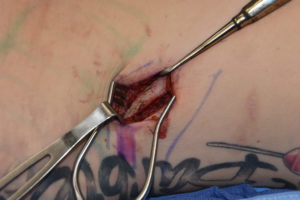Rib removal is an effective surgery for anatomic waistline reduction. It is reserved for those women who have tried every other non-surgical and surgical method to narrow their waistlines and are seeking the last resort to do so. It is clearly for the most motivated of women who are willing to accept small back scars to do so.
Removal of the lower ribs does work to narrow the waistline by eliminating some structural support that helps hold the wasitline out. The lowermost two ribs, #s 11 and 12, are called the floating ribs because they are attached only to the vertebrae and not to the sternum or cartilage of the sternum. These ribs taper down to a cartilaginous tip where soft tissues attach. The floating ribs are often called small and delicate but they are not really either. Having taken out many of them they are much longer and stouter than one would think or diagrams show.

Seeing their downward angulation during surgery allows for an appreciation of why it works for anatomic waistline narrowing. They do go as far down as almost the iliac crest which provides some support to the width of the waistline. It is also clear why some people may complain that they feel their ribs touch their hip bones when they bend to the side…because they in fact do.
Dr. Barry Eppley
Indianapolis, Indiana


